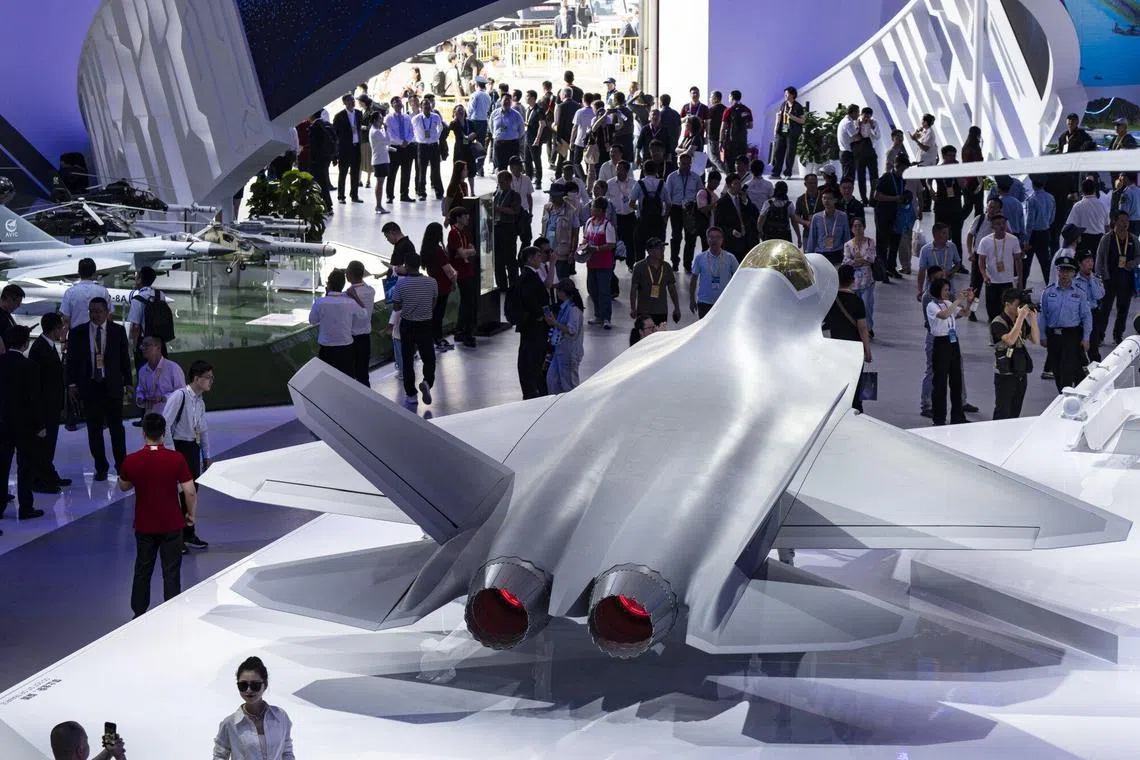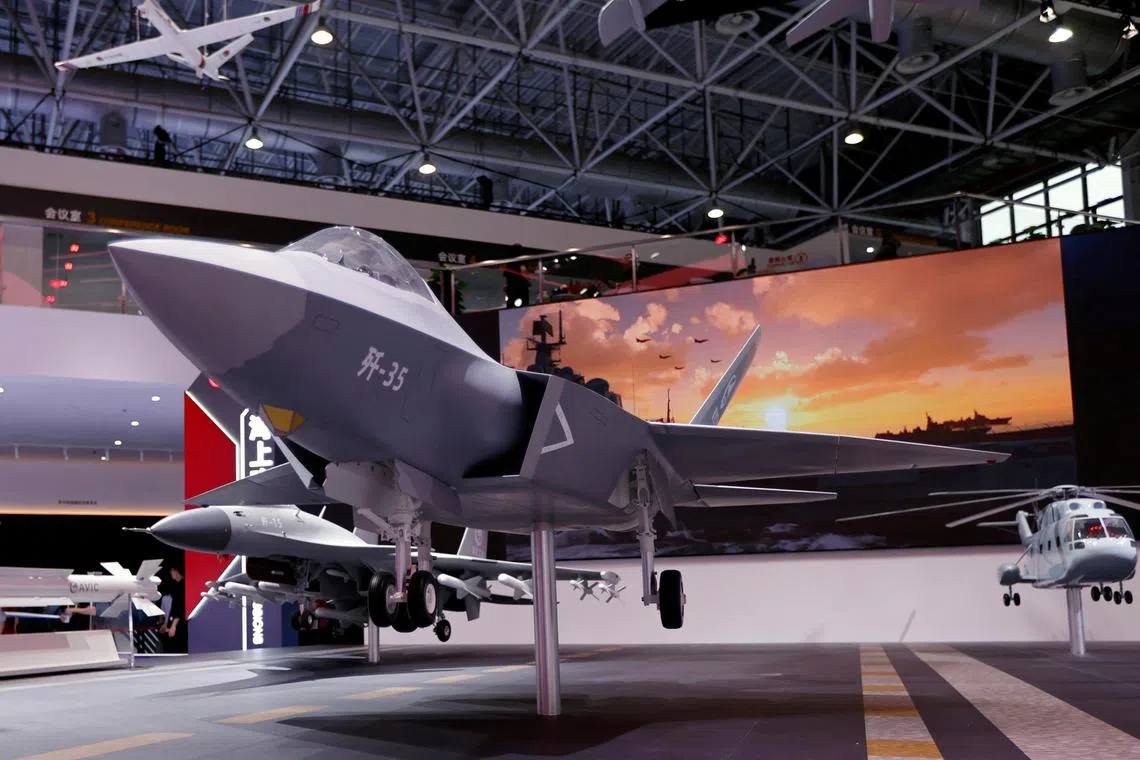Commentary
China’s new J-35 fighter jet thrills at air show, but can it sell?
Sign up now: Get insights on Asia's fast-moving developments

China may find it difficult to find international buyers for the J-35, even if it does live up to its hype.
PHOTO: BLOOMBERG
Follow topic:
BEIJING - China’s latest stealth fighter jet, the J-35, made its public debut at the Zhuhai Airshow this week, wowing crowds with a series of steep dives and climbs during its aerial displays.
As China’s answer to the American F-35 Joint Strike Fighter, the J-35 is considered a fifth-generation jet,
Its reveal was seen by local and international media as the highlight of China’s largest air show,
This is China’s second foray into fifth-generation fighter jets, following the J-20, which entered service in 2017. The J-20 is considerably larger than the J-35 and is not for sale, owing to sensitive technology on board.
Other than showcasing its growing military might and technological prowess, however, China could have economic objectives for the reveal.
In recent years, China has reaped the fruits of investments into technology as it sought to export a range of platforms, from the Beidou satellite navigation system to nuclear reactors.
Advanced fighter jets could well be the next market China eyes. Close partner Pakistan could be the J-35’s first non-Chinese operator, with its air force chief saying in January that the FC-31 – the J-35’s predecessor – would enter service “in the near future”.
Next-generation fighter jets are a strategic capability whose sales could signal yet another step taken in China’s ascendence as a global power.
Yet with a smaller circle of rich and militarily powerful allies compared with Washington, China may find it difficult to find international buyers for the J-35, even if it does live up to its hype.
Market gap?
Despite the J-35 generating considerable excitement and making headlines in China, very little data has been released about its performance and capabilities, and it remains very much a “black box” to outsiders.
Designed and built by the Shenyang Aircraft Corporation, a subsidiary of the state-owned Aviation Industry Corporation of China, the J-35 is expected to be capable of being deployed on aircraft carriers, enhancing China’s ability to project forces in the region.
Toe-to-toe, based on available specifications, the J-35 is broadly comparable with the F-35, although the Lockheed Martin jet has since accumulated far more flight hours and combat experience.
Military aerospace expert Douglas Barrie believes it is still too early to draw implications for the Chinese military’s combat power, including in relation to its strategic rival, the US.
The significance will become fully apparent only when, and if, the aircraft enters the People’s Liberation Army Air Force’s inventory, said Mr Barrie, noting that its development has so far proceeded at a much slower pace than that of the Chengdu J-20.
Now, the J-35 could fill a gap in the global market for countries from the Middle East and Central Asia looking for upgrades to their fighter fleets, but that have been shut out from US military equipment. Its earlier iteration, the built-for-export FC-31, was estimated to cost US$70 million (S$93.8 million) in 2017, compared with between US$80 million to more than US$100 million for the F-35, depending on the variant.
China’s offering might also tempt foreign buyers away from Russia, another traditional arms export heavyweight, who is hoping to export its own fifth-generation Su-57 fighter.
Who are these potential buyers? Egypt may be one. Cairo in September reportedly decided on China’s J-10C fourth generation-plus fighter jets to replace its ageing US F-16 fleet, as part of efforts to diversify its military suppliers, becoming the second international customer for that jet after Pakistan.
Egypt has been blocked by the US from buying the F-35 over concerns from Israel – the only operator of the F-35 in the Middle East.
The Joe Biden administration has also restricted military aid to Egypt on alleged human rights violations – although this was eased in September.
Similarly, a potential sale of 50 F-35s to the United Arab Emirates (UAE) has also stalled, given US concerns over Abu Dhabi’s growing ties with China, including the building of a suspected Chinese military base there.
A third candidate is Azerbaijan, which received the fourth-generation JF-17 jet co-developed by China and Pakistan in September – months after China and Azerbaijan upgraded relations to a strategic partnership in July.
If successful, China’s growing arms sales and technological leadership may strengthen its positioning as an alternative strategic partner. This could strengthen its appeal as a global power amid dissatisfaction with American leadership and restrictions.
But the US still takes up the lion’s share of the lucrative global arms sales market. For combat aircraft specifically, the US has more than 1,000 of them on order for delivery after 2023, including 785 F-35s, according to the Stockholm International Peace Research Institute. China has just 94 such aircraft on order.
China is making inroads in some areas, leading in sales of combat drones that can fire air-to-surface missiles, which have been used by countries from Myanmar to Yemen. The UAE and Egypt also operate China’s Wing Loong drone, a competitor to the American MQ-9.
Part of that appeal, said Mr Richard Aboulafia, managing director of AeroDynamic Advisory consultancy, is that Western drones are typically accompanied by strong regulations prohibiting types of use and export customers.
Chinese drones have no such impairments, and that makes them very popular, he added.

The J-35 is considered a fifth-generation jet, or the most advanced series in operation today, with its stealth capabilities, manoeuvrability and sleek design.
PHOTO: REUTERS
Strategic asset
But selling fighter jets are a trickier affair, as they entail deeper political and security considerations when compared with drones, which are far cheaper and more expendable.
China remains a minor fighter jet supplier. According to the Stockholm International Peace Research Institute, China exported US$7.4 billion of military aircraft between 2000 and 2020, far behind market leaders Russia (US$62.8 billion) and the US (US$99.6 billion).
Mr Aboulafia said a fighter market buyer would want strategic alignment with the seller in order to minimise the risk of a support cut-off.
Such a risk of not having spare parts supplied could be present, for instance, for countries with territorial disputes with China in the South China Sea, he added.
“This is particularly true for fifth-generation aircraft, which require regular software updates, and can probably even be ‘turned off’ by the selling country.”
There’s also the risk of alienating the US, he said. American officials worry over Chinese espionage, especially for cutting-edge weaponry like the F-35.
Very few countries fall into this category of both being unconcerned about being cut off from the US and able to afford and use fifth-generation fighters, said Mr Aboulafia.
“That’s why Egypt is so intriguing – they’re one of the few countries willing and financially able to make that shift.”
Mr Barrie, who is senior fellow at the International Institute for Strategic Studies, said that another potential drawback for an export customer – assuming the design is genuinely low observable – would be to maintain the aircraft’s stealth characteristics after maintenance.
“China has little experience in providing maintenance support to export customers when it comes to modern combat aircraft, though this should improve over time.”
America, even for all its military technological superiority, encountered challenges in its Joint Strike Fighter development programme. In January, it was reported that the 1,000th F-35 had been built, a key milestone for the now-mature warplane, even as the programme has been marred by delays and other controversies.
While China has made remarkable strides in military modernisation and defence industrial growth, in a more multipolar world, where countries – including those in South-east Asia – appear to be hedging, counterbalancing and diversifying, rather than foreclosing options by choosing one way or another, the J-35 offers an interesting fork in the road.
With next-generation fighter technology increasingly representing a binary choice, there lies the rub for the J-35’s export prospects, even as it soars to new heights.

